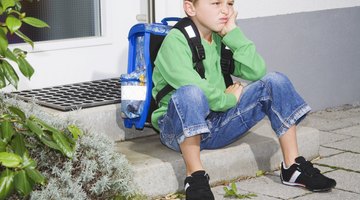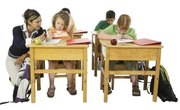In years past, students who had emotional and behavioral disorders, or EBD, were kept separated from students who were in general education classrooms. In the current educational system, however, students with emotional and behavioral disorders are often given accommodations in a general education setting. What sort of accommodations the student requires depends on the student's age and level of disability.
Elementary School
EBD is a classification under special education and is usually defined by a list of behaviors, such as trouble following directions, behaving oppositionally and acting aggressively toward others. Within the special education system, about one percent of the total student population is identified as having an emotional and/or behavioral disorder and as being in need of specialized services. According to the University of Wisconsin, Whitewater, modeling of appropriate behavior and rewarding positive behavior are the most effective way to address this in elementary school classrooms. Some teachers use behavior charts to reward positive behavior. Other teachers use goal sheets. Some teachers use a ticket system and allow the student to choose prizes according to the number of tickets he or she has earned each day or each week.
Middle School
In middle school, EBD students begin to shift toward controlling their own behavior and learn what situations trigger their anger or impulsiveness. "Creating Rules for Classrooms," a publication prepared by the California Department of Education, suggest allowing EBD students to participate in making classroom rules so that they are better able to relate to the rules and procedures in the classroom. Also, middle school students should make guided choices about class groupings because some EBD students work well in a small group, while other EBD students need to be alone to focus. Ideally, EBD students should be allowed to practice choice with guidance from the teacher so they become more independent and confident in the classroom, according to "Creating Rules for Classrooms." Letting the student choose his or her own behavioral goal is another way of giving an EBD student choice within the classroom setting.
High School
EBD students in high school face a difficult struggle. Many of them have difficulty completing high school, and thus many drop out. High school is the place where EBD students need to begin to branch out and find what motivates them, makes them successful and prepares them for the world of work or further education. Both peer tutoring and self-monitoring strategies can be tried with EBD high school students. Teachers should strive to help EBD students find what challenges and motivates them. Also, teachers of EBD students at the high school level should have a group of people to work with, such as counselors, special education teachers or outside therapists or a social workers, so that the student is ready to transition out of high school. The goal for an EBD student is to learn success outside of the classroom doors.
Support for Teachers
Students with EBD may be helped with a behavior chart or goal sheet, according to the National Dissemination Center for Children with Disabilities. Teachers who want to use behavior charts should first pick a few behaviors they want to encourage. For younger students, teachers may want to concentrate on one or two behaviors or goals and write them in student language, such as "I will sit quietly during circle time," or "I will use nice language when I talk to my friends." For middle school and high school students, the goals may be more complicated, so they might read, "I will find a different part of the room to go to if I get frustrated," or "I will try to write a paragraph alone before I ask for help." The teacher may determine if the student has met the goal, or she may allow the student to self-monitor. The student's goal sheet should include daily or weekly goals.
Related Articles
References
Resources
Writer Bio
Lori Garrett-Hatfield has a B.J. in Journalism from the University of Missouri. She has a Ph.D. in Adult Education from the University of Georgia. She has been working in the Education field since 1994, and has taught every grade level in the K-12 system, specializing in English education, and English as a Second Language education.











